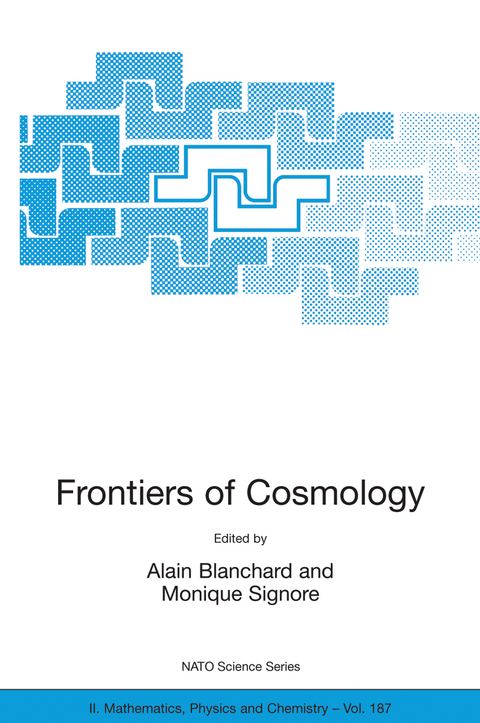
Frontiers of Cosmology
Springer-Verlag New York Inc.
978-1-4020-3055-0 (ISBN)
The ?eld of cosmology is currently undergoing a revolution driven by d- matic observational progress and by novel theoretical scenarios imported from particle physics. In particular, two most remarkable results were recently - tained from measurements of the angular spectrum of the ?uctuations in the Cosmic Microwave Background (CMB) radiation providing convincing e- dence that the Universe is nearly ?at and from the Hubble diagram of distant supernovae indicating an accelerating expansion rate, which implies the ex- tence of some dark energy as the dominant component of the Universe. Indeed, the next decade will bene?t from high quality data on cosmology from diff- ent major experiments and observatories, with a particular important contri- tion from space missions such as WMAP, Planck Surveyor, XMM and SNAP among others. On one side, cosmologists believe they understand the origin of themain ingredients which allowacoherent description of theUniverse from its very earlyphase, namely in?ation, to the actual epoch which accounts for theoriginof theprimordial?uctuations, allowing predictions of their - prints inthe cosmicmicrowave skyandleading to the large scale structure of theUniverse as observed.
Ontheother side, theexistence of a non-zero vacuum density is certainly one of the most astonishing results of modern f- damental physics. Understanding its nature andits originwill be one of the major directions of researchinthe following years. In view of the intensive current activity inthe ?eld,aSchoolfully dedicated to these both sides in cosmology was timely.
Dedication, Preface Acknowledgments;
1 Basics of Cosmology
1. Geometry and Dynamics ; 2.Important quantities needed for observations
3. Some solutions of EFL equations:some cosmological models; 4. The standard Big Bang Nucleosynthesis (SBBN);5. Observations of ``primordial abundances'; 6. Confrontation of the observed ``primordial abundances'' to the predictions of the sBBN; Conclusions; References
2 X-ray View of Galaxy Clusters,
1. Observing Clusters in X-rays -- the Chandra Observatory;2. Regular Clusters XD Cooling Flows A478;3. Physics of Cluster Cores; Acknowledgments; References;
3 Clusters: an optical point of view;
1. Cluster detections in the optical;2. Studies of clusters;3. Acknowledgements;References
4 Cosmology with Clusters;
1. Introduction;2. What is a cluster? ; 3. The spherical model;4. The mass function;
5. Connection to the observations; 6. Properties of Clusters and scaling relations; 7. Clusters abundance evolution; 8. The baryon fraction; 9. Conclusion; References
5 Astrophysical detection of Dark Matter ;
1. Signals from the Dark universe ; 2. Inference probes;3. Physical probes;4. Conclusion; References
6 Non-thermal processes in galaxy clusters ;
1. Non-thermal and relativistic phenomena in galaxy clusters;2. The origin of cosmic rays in galaxy clusters; 3. The astrophysics of cosmic rays in galaxy clusters ; 4. Conclusions; References
7 Cosmological Inflation ;
1. Introduction; 2. The hot Big-Bang scenario and its problems ;3. Inflation and inflationary dynamics;4. Basics of cosmological perturbations ;Synchronous gauge;Longitudinal or Newtonian gauge; Flat-slicing gauge ; 5. Inflationary perturbations; 6. Basics of quantum field theory;7. Perturbation spectrum; 8. Conclusion; References
8 An introduction to quintessence ;
1. The two cosmological constant problems;2. A scalar field asdark energy;3. Stability of the wQ = Const regime ;4. Model building;5. Dark energy and structure formation; 6. Observational status; References
9 CMB Observational Techniques and Recent Results
1. Introduction;2. Observational Techniques ;3. Recent Observations; 4. Summary; Acknowledgments; References;
10 Fluctuations in the CMB ; Andrew H. Jaffe
1. Introduction;2. Cosmological Preliminaries; 3. The Last Scattering Surface ; 4. Perturbations on Large and Small Scales;5. Oscillations in the Primordial Plasma;6. The Power Spectrum of CMB Fluctuations;7. The CMB and Cosmological Parameters;8. Conclusions; Acknowledgments; References
11 Supernovae as astrophysical objects;
1. Some History;2. Supernova classification;3. Input Energy;4. Core-collapse supernovae ;
5. Type Ia supernovae ;6. Conclusions; References
12 Cosmology with Supernovae ;
1. Introduction;2. The Hubble constant;3. The expansion history of the universe;4. Universal acceleration according to Type Ia supernovae ;5. Characterising dark energy ;6. Conclusions; References
13 Gravitational lensing;
1. Introduction;2. Physical mechanisms; Multiple images and displacement field;The amplification matrix ;3. Gravitational lenses in Cosmology;The case of a spherically symmetric mass distribution;Critical lines and caustics in realistic mass distributions; 4. Cosmic Shear: weak lensing as a probe of the large-scale structure;5. Conclusions and perspectives: cosmic shear in a precision;Cosmology era; References
14 Dark Matter ;
1. Introduction;2. Local Dark Matter;3. Clusters and Groups of Galaxies;4. Masses of Galaxies ;
5. The Nature of Dark Matter;6. Summary;Acknowledgments;References
15 Dark Matter and Galaxy Formation;
1. Challenges of dark matter;2. Global baryon inventory;3. Confirmation via detailed census of MWG/M31; 4. Hierarchical galaxy formation;5. Unresolved issues in galaxy formation theory; 6. Resurrecting CDM ;7. An astrophysical solution: early winds;8. Observing CDM via the WIMP LSP; 9. The future ; References
16 Non-Baryonic Dark Matter;
1. The need for non-baryonic dark matter;2. Popular candidates for non-baryonic dark matter; 3. Neutralino dark matter searches; High energy neutrinos from the core of the Sun or of the Earth; Gamma-rays and cosmic rays from neutralino annihilation in galactic halos;Signals from neutralino annihilation at the Galactic Center; 4. Conclusions ; References
| Erscheint lt. Verlag | 10.5.2005 |
|---|---|
| Reihe/Serie | NATO Science Series II: Mathematics, Physics and Chemistry ; 187 |
| Zusatzinfo | X, 333 p. |
| Verlagsort | New York, NY |
| Sprache | englisch |
| Maße | 156 x 232 mm |
| Themenwelt | Naturwissenschaften ► Physik / Astronomie ► Astronomie / Astrophysik |
| ISBN-10 | 1-4020-3055-X / 140203055X |
| ISBN-13 | 978-1-4020-3055-0 / 9781402030550 |
| Zustand | Neuware |
| Haben Sie eine Frage zum Produkt? |
aus dem Bereich


